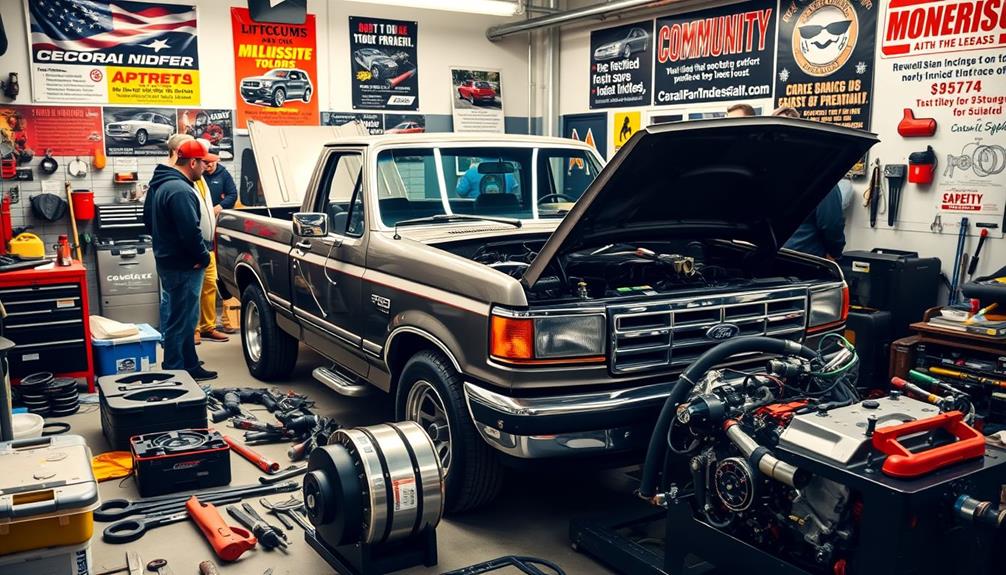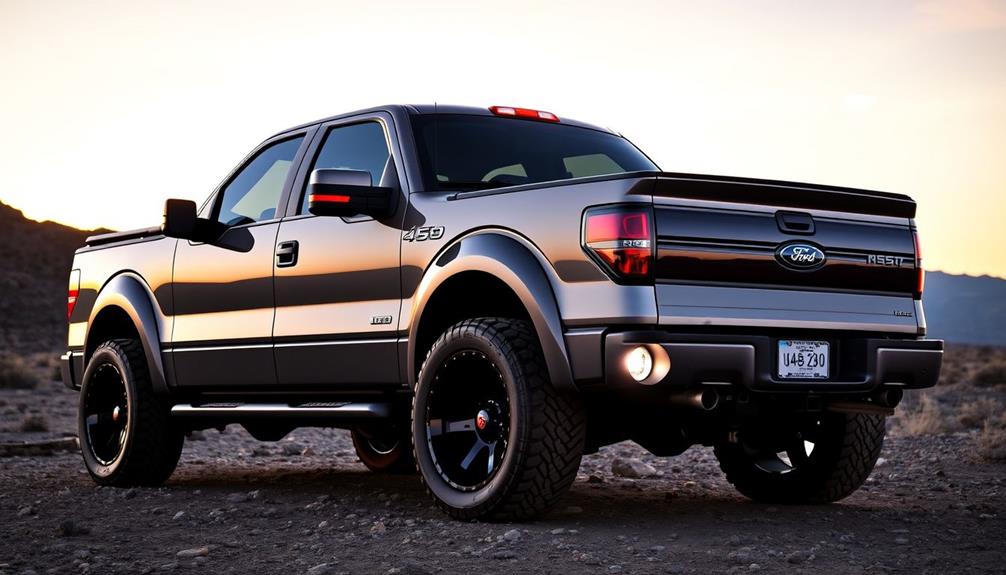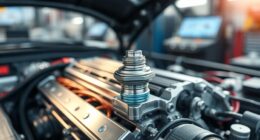Tuning your '93 Ford F-150 is a solid way to boost both power and efficiency. Start by upgrading the exhaust system—full-length headers and high-flow options can greatly improve airflow. Next, consider installing a performance tuner to recalibrate your engine for max torque and horsepower. Regular maintenance, like spark plug replacements and clean air filters, keeps your engine running smoothly. Also, consult with fellow enthusiasts to gather tips on the best modifications for your ride. With the right upgrades, you'll transform your pickup's performance and fuel efficiency, making it more enjoyable to drive. There's much more to explore!
Key Takeaways
- Upgrade the exhaust system with full-length headers and high-flow components to boost airflow and reduce back pressure for improved performance.
- Install a performance tuner like the SCT X4 to recalibrate engine parameters and enhance throttle response and fuel efficiency.
- Consider a performance camshaft and upgraded intake manifold to increase engine breathing and air intake, maximizing horsepower.
- Regular maintenance, including spark plug replacement and clean air filters, is essential for optimal engine performance and longevity.
- Engage with Ford F-150 enthusiast communities for insights and recommendations on effective performance upgrades and tuning strategies.
Engine Specifications
When tuning your 1993 Ford F-150, understanding the engine specifications is essential. This model features a 5.0L 302 small block engine, which was a game-changer as it introduced fuel injection to the F-150 lineup.
Thanks to the Electronic Fuel Injection (EFI) system, you'll experience improved fuel efficiency and enhanced overall performance compared to older carbureted systems.
The stock engine generates approximately 190 horsepower and 270 lb-ft of torque, providing a solid foundation for any tuning enthusiast. To maximize your F-150's potential, it's vital to know the factory specifications, including compression ratios and ignition timing.
These details are key when planning any modifications you might want to undertake. For example, upgrading the exhaust system can greatly impact your engine's power output. A performance exhaust can help your engine breathe better, improving both horsepower and torque.
Additionally, if you're considering modifications like a new camshaft, understanding your engine specifications will guide you in selecting components that work harmoniously with your stock setup. By grasping these fundamentals, you're setting the stage for effective tuning and better performance in your F-150.
Performance Upgrades

When you're looking to boost your '93 Ford F-150's performance, several key upgrades can make a noticeable difference.
Upgrading the exhaust system, installing a performance tuner, and enhancing engine modifications can all lead to significant gains in horsepower and torque.
Let's explore how these changes can transform your truck into a powerhouse on the road.
Engine Modifications Overview
Upgrading the engine in your 1993 Ford F-150 can greatly boost its performance and driving experience. A solid engine modifications overview reveals several key upgrades that can help you add horsepower and torque.
First, consider upgrading the camshaft. A performance camshaft improves engine breathing and efficiency, leading to substantial power gains.
Pair this with full-length headers and a high-flow exhaust system. These modifications enhance airflow and reduce back pressure, allowing your engine to perform at its best.
Next, modifying the intake manifold to a performance version, like the Shelby GT350, can further improve air intake and engine response.
When combined with headers and a tuner, the results are impressive. Speaking of tuners, using devices like the SCT X4 lets you recalibrate your engine's computer, optimizing air/fuel ratios and ignition timing for enhanced throttle response.
Lastly, don't forget regular maintenance. Replacing spark plugs and ensuring proper air filtration helps maintain the performance benefits from your upgrades.
Exhaust System Enhancements
To enhance the performance of your 1993 Ford F-150, consider upgrading the exhaust system. A full exhaust system upgrade—including headers, an x-pipe or h-pipe, high-flow catalytic converters, and performance tips—can greatly reduce factory restrictions. This not only improves horsepower but also gives your truck a more aggressive sound.
Here's a quick overview of essential upgrades:
| Component | Benefit |
|---|---|
| Full-Length Headers | Better torque and efficiency |
| High-Flow Catalytic Converters | Reduced back pressure and improved flow |
| Larger Diameter Piping | Enhanced performance for modified engines |
| Quality Brands (Flowmaster, MagnaFlow) | Options for sound and performance balance |
When installing, make certain to maintain the O2 sensor placement near its factory position to preserve engine efficiency. Remember, the diameter of your exhaust system plays a vital role in back pressure; opting for a larger diameter often results in better exhaust flow. Following these performance tips will guarantee that your F-150 not only sounds great but also performs at its best.
Tuner Installation Benefits
Installing a tuner like the SCT X4 can dramatically boost your 1993 Ford F-150's performance by recalibrating engine parameters for peak torque and horsepower.
One of the key tuner installation benefits is the ability to enhance your truck's efficiency and responsiveness. With custom tunes from reputable companies like Bama and Lund Racing, you can tailor the tuning specifically to your upgrades, maximizing the gains from performance modifications such as exhaust systems and cold air intakes.
The installation process is typically straightforward and plug-and-play, requiring minimal mechanical knowledge or tools. This means you can enjoy improved performance without the hassle of complicated setups.
Additionally, dyno tuning allows for precise adjustments that enhance throttle response and overall engine efficiency, providing a cost-effective alternative to pricey supercharger kits.
You'll also notice a boost in fuel efficiency alongside the performance gains, making this investment even more appealing.
Whether you're looking for increased power for towing or just want a more enjoyable driving experience, the benefits of tuner installation are clear. Embrace the enhancements and take your F-150 to the next level!
Exhaust System Options

When considering exhaust system options for your '93 Ford F-150, it's important to compare different header types and their impact on performance.
You'll also want to think about the exhaust diameter, as it plays a vital role in reducing back pressure.
Popular aftermarket brands like Flowmaster and MagnaFlow can help you achieve the perfect balance of sound and power tailored to your preferences.
Header Types Comparison
Although many F-150 enthusiasts consider various options for improving their truck's performance, the choice between full-length and shorty headers is fundamental for maximizing exhaust efficiency. Full-length headers are often preferred for the 1993 Ford F-150 since their longer tubing design provides increased torque and improved exhaust flow. In contrast, shorty headers can be easier to install but may not offer the same performance benefits.
Here's a quick comparison of the two header types:
| Header Type | Benefits |
|---|---|
| Full-Length Headers | Increased torque, better exhaust flow |
| Shorty Headers | Easier installation, compact design |
When selecting headers, consider the exhaust diameter as it plays a significant role in back pressure. Larger diameters typically reduce back pressure, enhancing overall performance. Popular aftermarket brands like Flowmaster and MagnaFlow offer high-quality full-length headers that can meaningfully improve both sound and performance for your F-150's 5.0L engine. Remember, proper placement of O2 sensors in aftermarket headers is essential to maintain fuel efficiency and avoid engine management issues.
Exhaust Diameter Impact
Choosing the right exhaust diameter is vital for maximizing your 1993 Ford F-150's performance. The diameter of your exhaust system notably impacts back pressure; a larger diameter generally reduces back pressure and enhances airflow. For your V8 engine, consider upgrading to an exhaust diameter ranging from 2.5 to 3 inches. This change can lead to remarkable gains in horsepower and torque, especially when paired with other performance modifications.
A larger exhaust diameter improves scavenging effects, allowing for more efficient expulsion of exhaust gases from the cylinders. This contributes to better throttle response and acceleration, making your drive feel more powerful.
However, it's important to find an ideal size. If the diameter is too large, you might lose low-end torque, which can affect drivability.
Carefully selecting the right exhaust diameter balances performance gains without sacrificing the driving experience. By considering these factors, you'll enhance your truck's performance while ensuring it remains enjoyable to drive.
Investing in the right exhaust system tailored to your needs will make a considerable difference in how your F-150 performs on the road.
Popular Aftermarket Brands
Upgrading your exhaust system opens the door to a variety of aftermarket brands that can enhance your 1993 Ford F-150's performance. Two of the most popular aftermarket brands are Flowmaster and MagnaFlow. These brands are renowned for their high-flow exhaust systems, which improve airflow and increase engine efficiency.
When considering your exhaust system upgrade, full-length headers are generally recommended over shorty headers, as they provide increased torque and better overall performance. A high-flow exhaust system considerably reduces back pressure, leading to potential horsepower gains, especially when combined with other performance modifications.
It's essential to maintain the O2 sensor placement close to factory specifications to preserve fuel efficiency and emissions compliance. Additionally, the diameter of your exhaust pipe plays an important role in performance; larger diameters typically deliver better results for modified engines.
Here's a quick comparison of popular aftermarket brands:
| Brand | Key Features | Price Range |
|---|---|---|
| Flowmaster | Aggressive sound, improved airflow | $400 – $800 |
| MagnaFlow | Deep tone, stainless steel build | $300 – $700 |
| Borla | High-quality performance, durable | $500 – $1,000 |
| Gibson | Bolt-on performance, easy install | $400 – $900 |
| Hooker | Affordable, decent performance | $250 – $600 |
Tuner and Programmer Benefits

Tuning your 1993 Ford F-150 with a performance tuner or programmer can release significant benefits for your driving experience. These devices allow you to modify essential engine parameters, such as air/fuel ratio and ignition timing, which can lead to a noticeable increase in horsepower and torque in your 5. 0L engine. Furthermore, performance tuners can also improve fuel economy by optimizing the engine’s efficiency. Additionally, they can correct any factory limitations or issues to ensure your engine is running at its peak performance. When considering Ford F150 tuning upgrade options, a performance tuner is a cost-effective solution that can enhance your vehicle’s overall performance and driving experience.
With options like the SCT X4, installation is often a breeze, enabling you to upload custom tunes tailored to your specific modifications and driving style.
One of the standout tuner and programmer benefits is the ability to utilize data logging. This feature enables you to monitor real-time engine parameters and troubleshoot any issues effectively. You'll gain insights into your vehicle's performance, allowing for better optimization and diagnostics.
Users frequently report enhanced throttle response and improved acceleration, creating a more engaging driving experience.
Additionally, a performance tuner or programmer can enhance your fuel efficiency. By optimizing engine performance, especially when paired with other upgrades like intake and exhaust systems, you can enjoy both power and savings at the pump.
Maintenance for Optimal Performance

To get the most out of your 1993 Ford F-150, regular maintenance is just as important as any tuning or upgrades. Prioritizing maintenance for peak performance guarantees your engine runs smoothly and efficiently.
Start by replacing spark plugs and coils periodically; this step is vital for maintaining engine performance and preventing power loss over time.
Don't forget routine oil changes and fluid checks. These practices help keep your engine healthy, prolong its lifespan, and enhance overall performance.
A clean air filter also plays a significant role, improving air intake for better fuel efficiency and engine performance.
Additionally, monitoring the fuel system, including regular replacement of fuel filters, prevents potential power loss and keeps your engine running consistently.
Legal Considerations for Modifications

When considering modifications for your 1993 Ford F-150, it's important to understand the legal landscape surrounding performance upgrades. The legality of these modifications varies by state, particularly concerning emissions regulations. Before you make a purchase, check your local laws to guarantee compliance, as certain upgrades could make your truck non-compliant.
Here's a quick overview of potential legal considerations:
| Modification Type | Legal Considerations |
|---|---|
| Aftermarket Exhaust Systems | May alter emissions profile |
| Catalytic Converter Changes | Removal can lead to fines |
| Performance Chips | Must comply with local laws |
| Lift Kits | May require permits/inspections |
Certain states enforce strict rules regarding catalytic converters. If you're looking to modify your vehicle, understanding these regulations is vital to avoid complications during inspections. It's advisable to consult local legislation, as some modifications may necessitate inspections or permits. By doing so, you can enjoy your upgrades without the risk of fines or vehicle impoundment. Stay informed, and utilize affiliate programs and affiliations to guarantee you're sourcing compliant parts for your F-150.
Community Insights and Recommendations

Ford F-150 enthusiasts have built a vibrant community that thrives on sharing insights and recommendations for tuning the '93 model. Engaging with this community can greatly enhance your tuning experience, leading you to effective performance upgrades and efficient aftermarket parts.
Here are three key tips from fellow enthusiasts:
- Optimal Modifications: Combine headers, high-flow exhaust systems, and quality tuning devices for maximum horsepower gains. These upgrades can dramatically improve your truck's performance.
- Focus on Airflow: Upgrading your exhaust system and installing a cold air intake can help maximize airflow, which is essential for enhancing engine performance. This is a common recommendation you'll see in community discussions.
- Network with Experts: Don't hesitate to reach out to experienced tuners in online forums. They can provide invaluable insights into effective aftermarket parts and help troubleshoot any issues you might face during your tuning journey.
Frequently Asked Questions
How to Make a Ford F-150 More Fuel Efficient?
To make your Ford F-150 more fuel efficient, upgrade to a high-flow air filter, use a performance tuner, maintain your tires, and consider a modern exhaust system. Regular maintenance also boosts your miles per gallon greatly.
How to Increase F-150 Horsepower?
Unleash your truck's hidden power! To boost your F-150's horsepower, consider upgrading the camshaft, installing a full exhaust system, and utilizing a tuner. Each tweak transforms your ride into a roaring beast on the road!
How Does the Ford F-150 Power Boost Work?
The Ford F-150 power boost works by recalibrating your engine's air/fuel ratio and ignition timing. You'll enhance performance and efficiency, maximizing horsepower and torque while ensuring peak operation through real-time monitoring and performance upgrades.
How Can I Improve My Throttle Response F-150?
Did you know that optimizing throttle response can improve acceleration by up to 30%? You can enhance your F-150's throttle response by installing a pedal controller, upgrading spark plugs, and tuning the engine for better performance.
Conclusion
In your quest to breathe new life into your '93 F-150, think of each upgrade as a brushstroke on a canvas, transforming a classic into a masterpiece of power and efficiency. By carefully choosing performance enhancements and tuning options, you're not just elevating your truck; you're crafting a legacy. Embrace these changes, maintain them diligently, and watch as your pickup becomes a symbol of your passion for performance and individuality on the open road.










